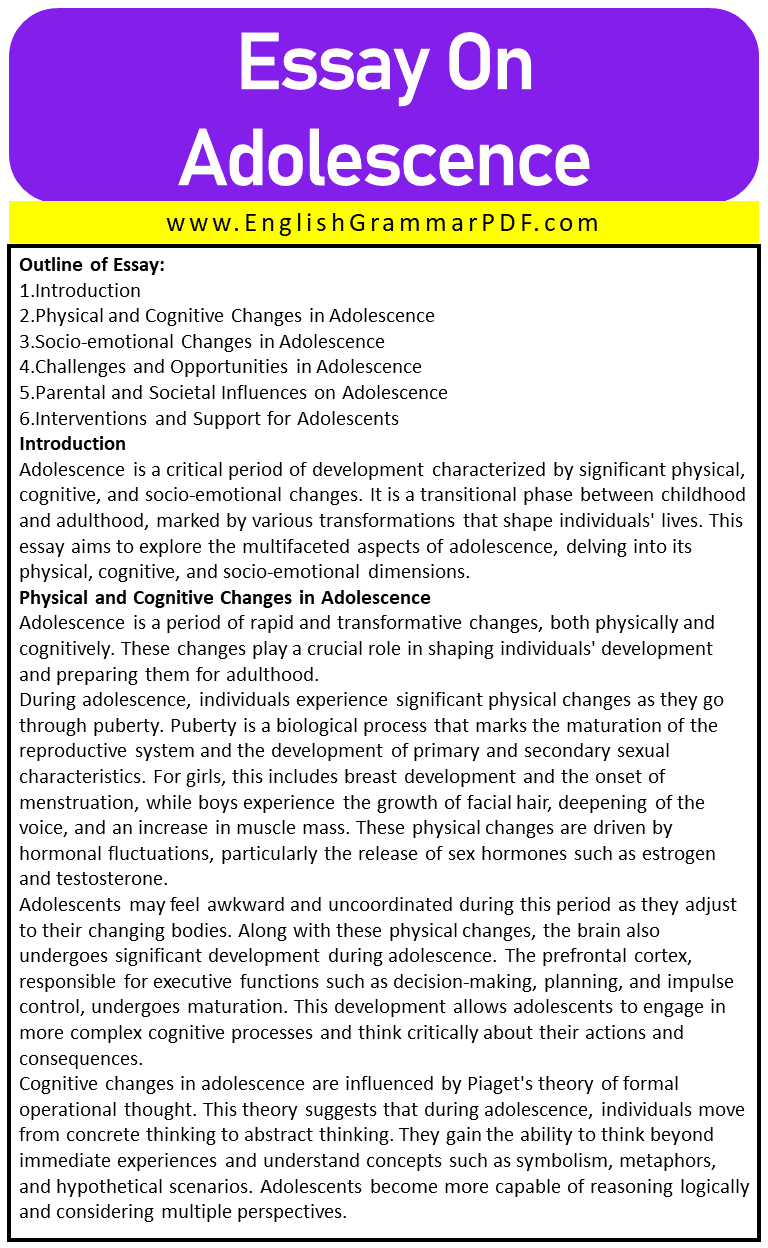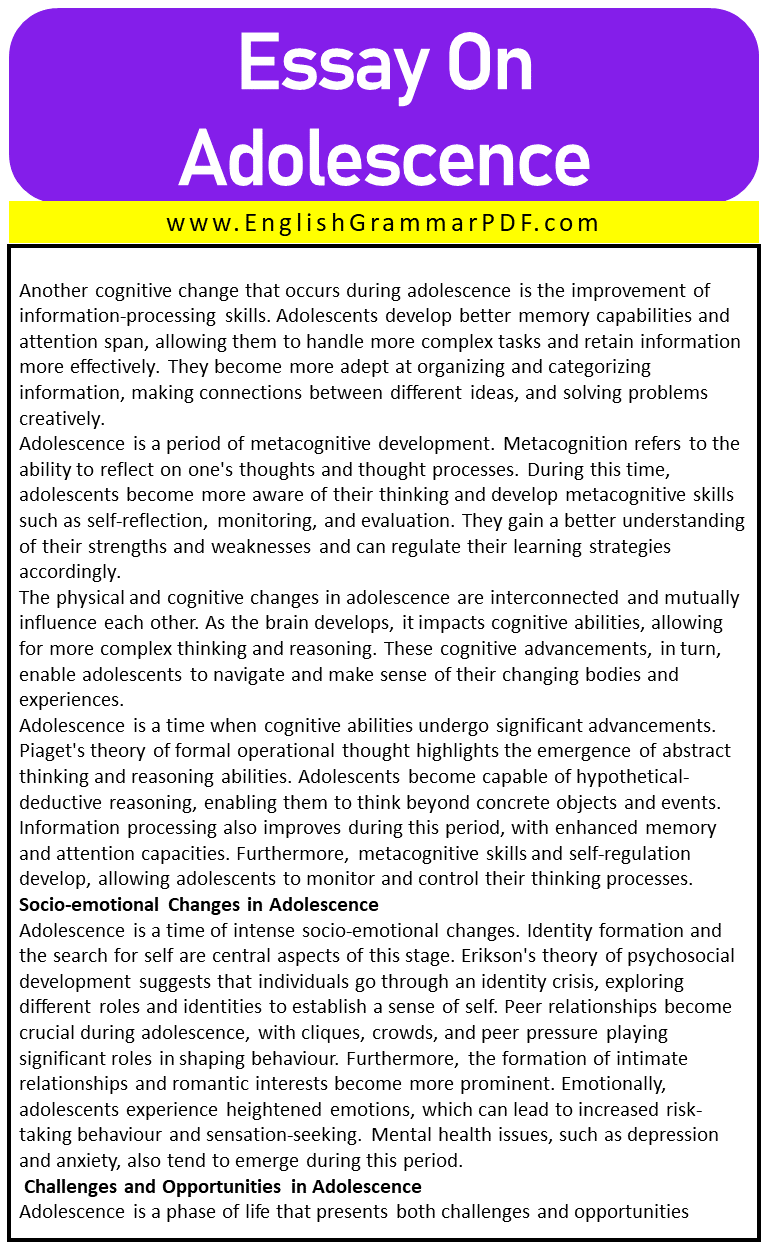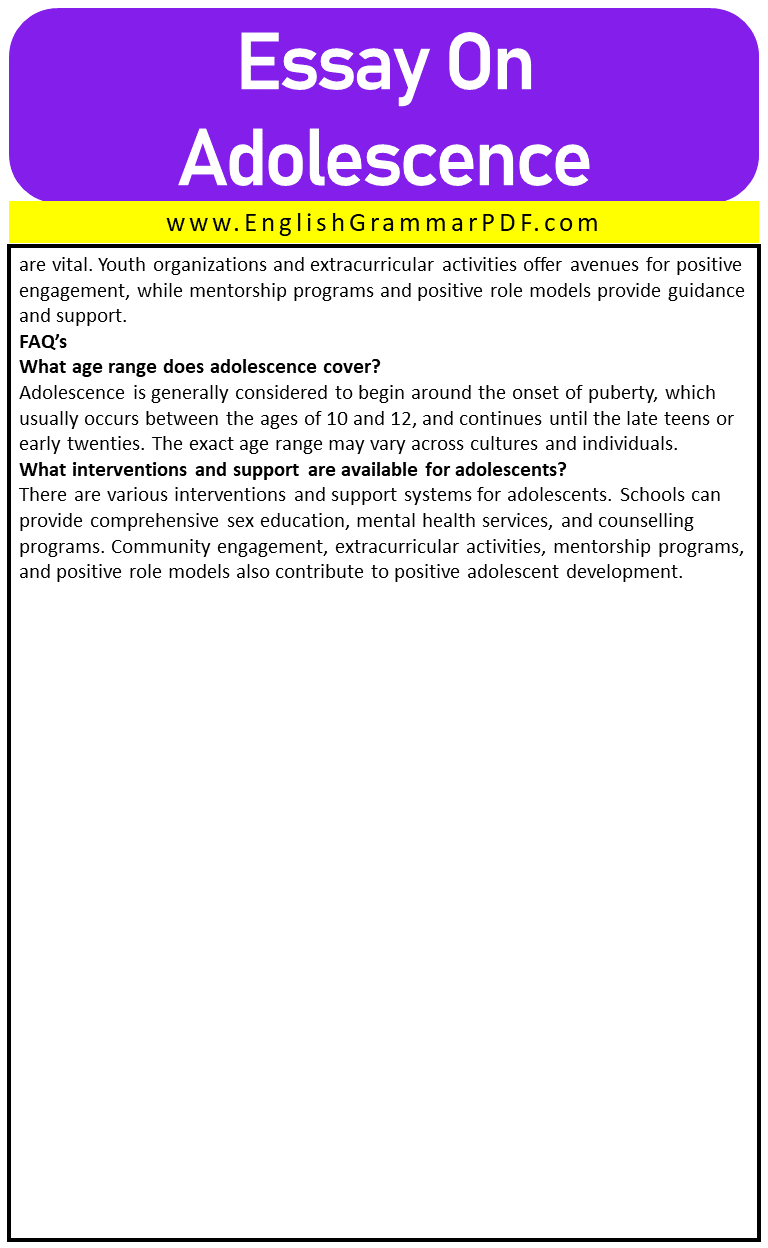Essay On Adolescence
Outline of Essay:
- Introduction
- Physical and Cognitive Changes in Adolescence
- Socio-emotional Changes in Adolescence
- Challenges and Opportunities in Adolescence
- Parental and Societal Influences on Adolescence
- Interventions and Support for Adolescents
Introduction
Adolescence is a critical period of development characterized by significant physical, cognitive, and socio-emotional changes. It is a transitional phase between childhood and adulthood, marked by various transformations that shape individuals’ lives. This essay aims to explore the multifaceted aspects of adolescence, delving into its physical, cognitive, and socio-emotional dimensions.
Physical and Cognitive Changes in Adolescence
Adolescence is a period of rapid and transformative changes, both physically and cognitively. These changes play a crucial role in shaping individuals’ development and preparing them for adulthood.
During adolescence, individuals experience significant physical changes as they go through puberty. Puberty is a biological process that marks the maturation of the reproductive system and the development of primary and secondary sexual characteristics. For girls, this includes breast development and the onset of menstruation, while boys experience the growth of facial hair, deepening of the voice, and an increase in muscle mass. These physical changes are driven by hormonal fluctuations, particularly the release of sex hormones such as estrogen and testosterone.
Adolescents may feel awkward and uncoordinated during this period as they adjust to their changing bodies. Along with these physical changes, the brain also undergoes significant development during adolescence. The prefrontal cortex, responsible for executive functions such as decision-making, planning, and impulse control, undergoes maturation. This development allows adolescents to engage in more complex cognitive processes and think critically about their actions and consequences.
Cognitive changes in adolescence are influenced by Piaget’s theory of formal operational thought. This theory suggests that during adolescence, individuals move from concrete thinking to abstract thinking. They gain the ability to think beyond immediate experiences and understand concepts such as symbolism, metaphors, and hypothetical scenarios. Adolescents become more capable of reasoning logically and considering multiple perspectives.
Another cognitive change that occurs during adolescence is the improvement of information-processing skills. Adolescents develop better memory capabilities and attention span, allowing them to handle more complex tasks and retain information more effectively. They become more adept at organizing and categorizing information, making connections between different ideas, and solving problems creatively.
Adolescence is a period of metacognitive development. Metacognition refers to the ability to reflect on one’s thoughts and thought processes. During this time, adolescents become more aware of their thinking and develop metacognitive skills such as self-reflection, monitoring, and evaluation. They gain a better understanding of their strengths and weaknesses and can regulate their learning strategies accordingly.
The physical and cognitive changes in adolescence are interconnected and mutually influence each other. As the brain develops, it impacts cognitive abilities, allowing for more complex thinking and reasoning. These cognitive advancements, in turn, enable adolescents to navigate and make sense of their changing bodies and experiences.
Adolescence is a time when cognitive abilities undergo significant advancements. Piaget’s theory of formal operational thought highlights the emergence of abstract thinking and reasoning abilities. Adolescents become capable of hypothetical-deductive reasoning, enabling them to think beyond concrete objects and events. Information processing also improves during this period, with enhanced memory and attention capacities. Furthermore, metacognitive skills and self-regulation develop, allowing adolescents to monitor and control their thinking processes.
Socio-emotional Changes in Adolescence
Adolescence is a time of intense socio-emotional changes. Identity formation and the search for self are central aspects of this stage. Erikson’s theory of psychosocial development suggests that individuals go through an identity crisis, exploring different roles and identities to establish a sense of self. Peer relationships become crucial during adolescence, with cliques, crowds, and peer pressure playing significant roles in shaping behaviour. Furthermore, the formation of intimate relationships and romantic interests become more prominent. Emotionally, adolescents experience heightened emotions, which can lead to increased risk-taking behaviour and sensation-seeking. Mental health issues, such as depression and anxiety, also tend to emerge during this period.
Challenges and Opportunities in Adolescence
Adolescence is a phase of life that presents both challenges and opportunities for individuals as they transition from childhood to adulthood. Alongside the exciting prospects of personal growth and independence, adolescents face numerous challenges that can shape their development.
One of the prominent challenges during adolescence is risk-taking behaviour. As adolescents seek new experiences and push boundaries, they may engage in risky behaviours such as substance abuse, reckless driving, or unprotected sexual activity. These behaviours can have serious consequences and impact their physical and mental well-being.
Furthermore, mental health disorders often emerge or become more pronounced during adolescence. Conditions such as depression, anxiety, and eating disorders can significantly affect an individual’s emotional and psychological well-being. Adolescents may struggle with managing stress, coping with peer pressure, and developing a positive self-image, adding to the complexity of their challenges.
However, adolescence also offers opportunities for positive development. It is a time when individuals begin to develop their values and beliefs, forming a sense of identity and purpose. They have the opportunity to explore their interests, passions, and talents, which can contribute to a stronger sense of self and personal fulfilment.
Adolescence is a period of acquiring essential life skills and independence. It is a time when individuals start to learn about financial responsibility, time management, decision-making, and problem-solving. They begin to make choices regarding their education, career paths, and future goals, shaping the trajectory of their lives.
Parental and Societal Influences on Adolescence
Parental and societal influences have a significant impact on adolescent development. Parent-child relationships play a crucial role in shaping the trajectory of adolescents’ lives. Effective parental monitoring and support contribute to positive outcomes, while authoritative parenting styles promote healthy development. Cultural and societal factors also influence adolescent experiences. The media, for instance, plays a role in shaping adolescents’ perceptions and expectations of themselves and their peers. Educational systems and their impact on academic achievement are also vital considerations.
Interventions and Support for Adolescents
To promote healthy development during adolescence, various interventions and support systems are essential. Schools play a significant role in this regard, offering comprehensive sexuality education to equip adolescents with knowledge and skills for responsible sexual behaviour. Mental health services and counselling programs within educational institutions are crucial for addressing mental health issues and providing support. Additionally, community engagement and support networks are vital. Youth organizations and extracurricular activities offer avenues for positive engagement, while mentorship programs and positive role models provide guidance and support.
FAQ’s
What age range does adolescence cover?
Adolescence is generally considered to begin around the onset of puberty, which usually occurs between the ages of 10 and 12, and continues until the late teens or early twenties. The exact age range may vary across cultures and individuals.
What interventions and support are available for adolescents?
There are various interventions and support systems for adolescents. Schools can provide comprehensive sex education, mental health services, and counselling programs. Community engagement, extracurricular activities, mentorship programs, and positive role models also contribute to positive adolescent development.
Explore More Essays:
Download the PDF of the Essay:







